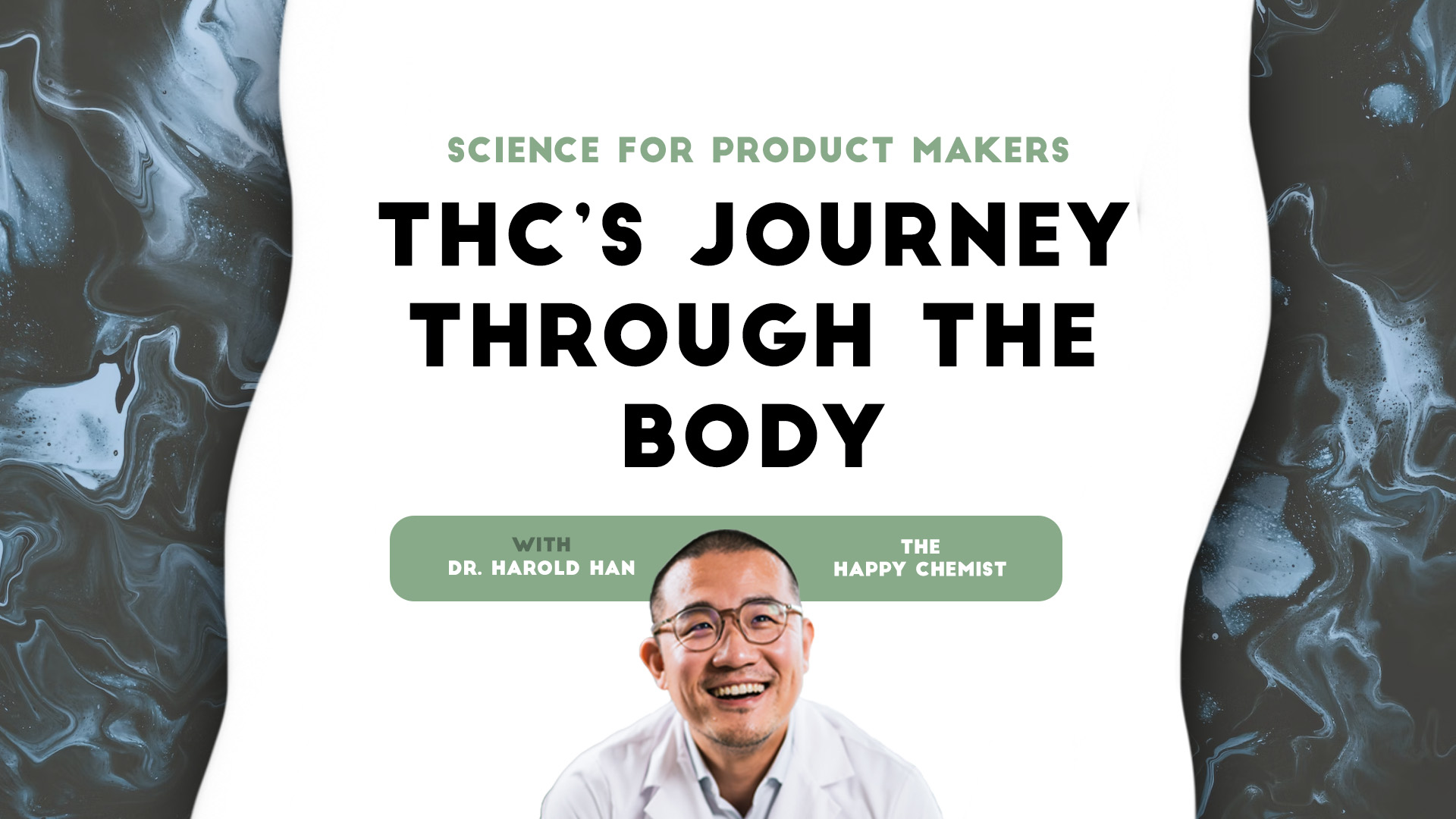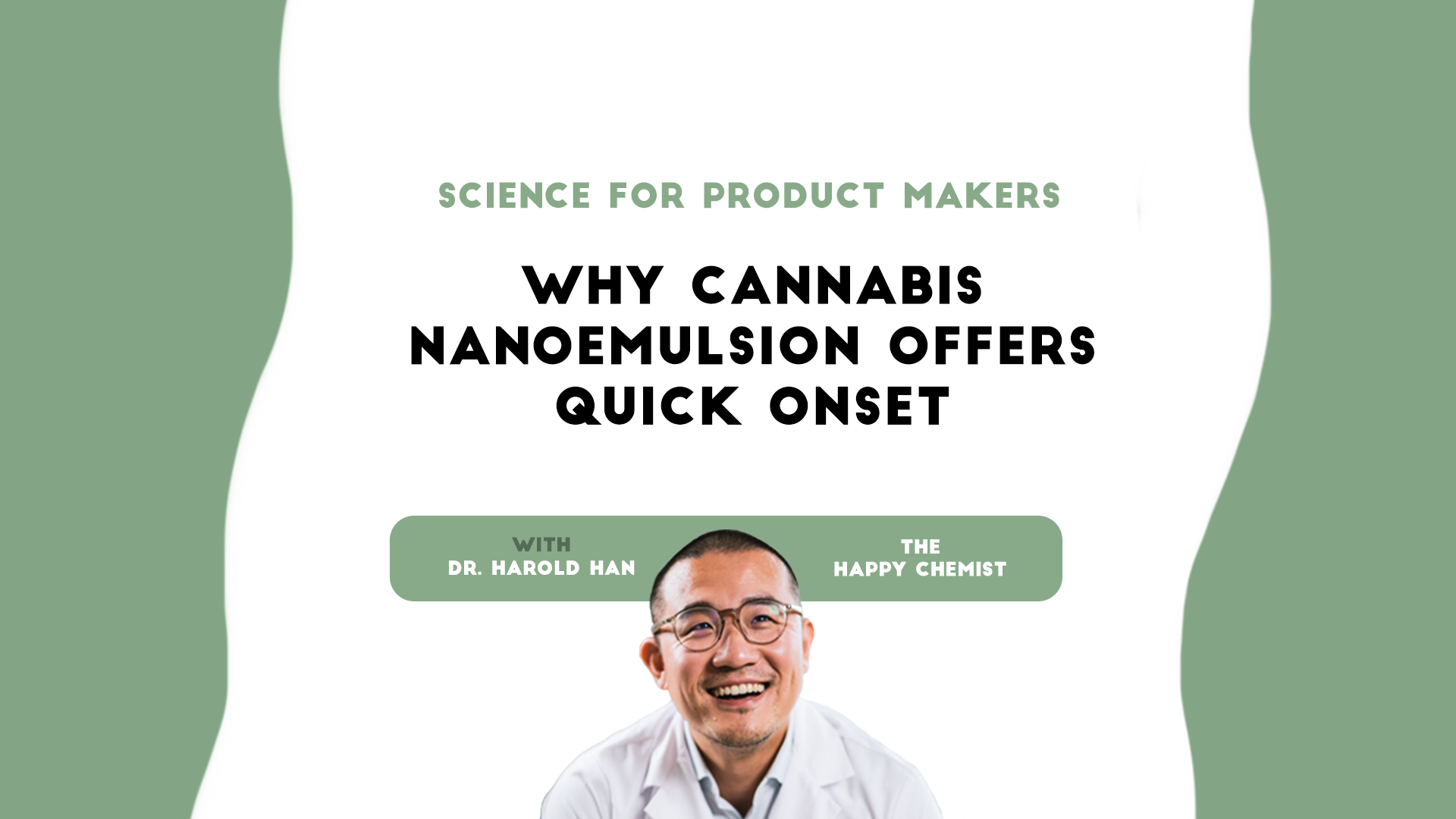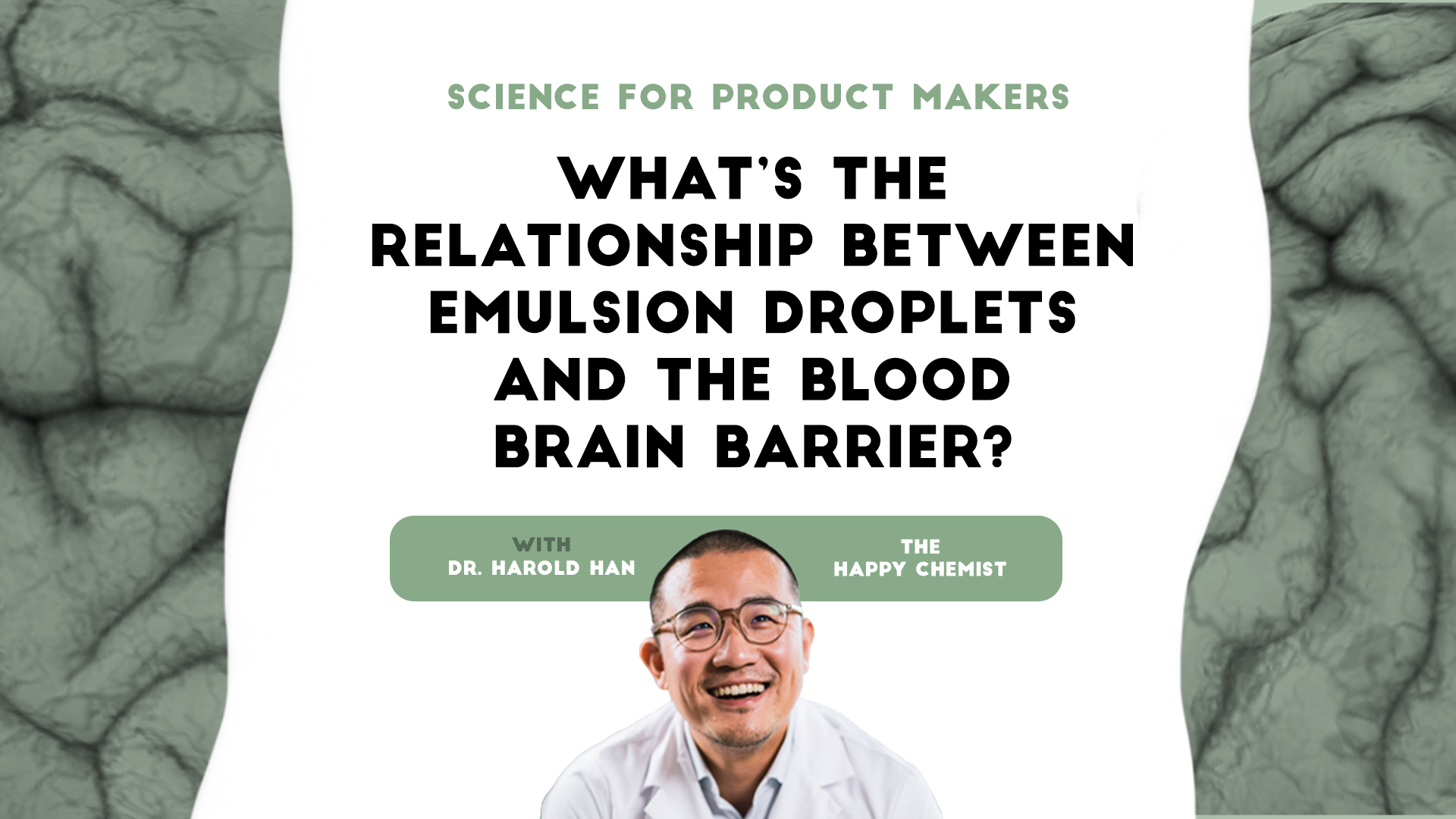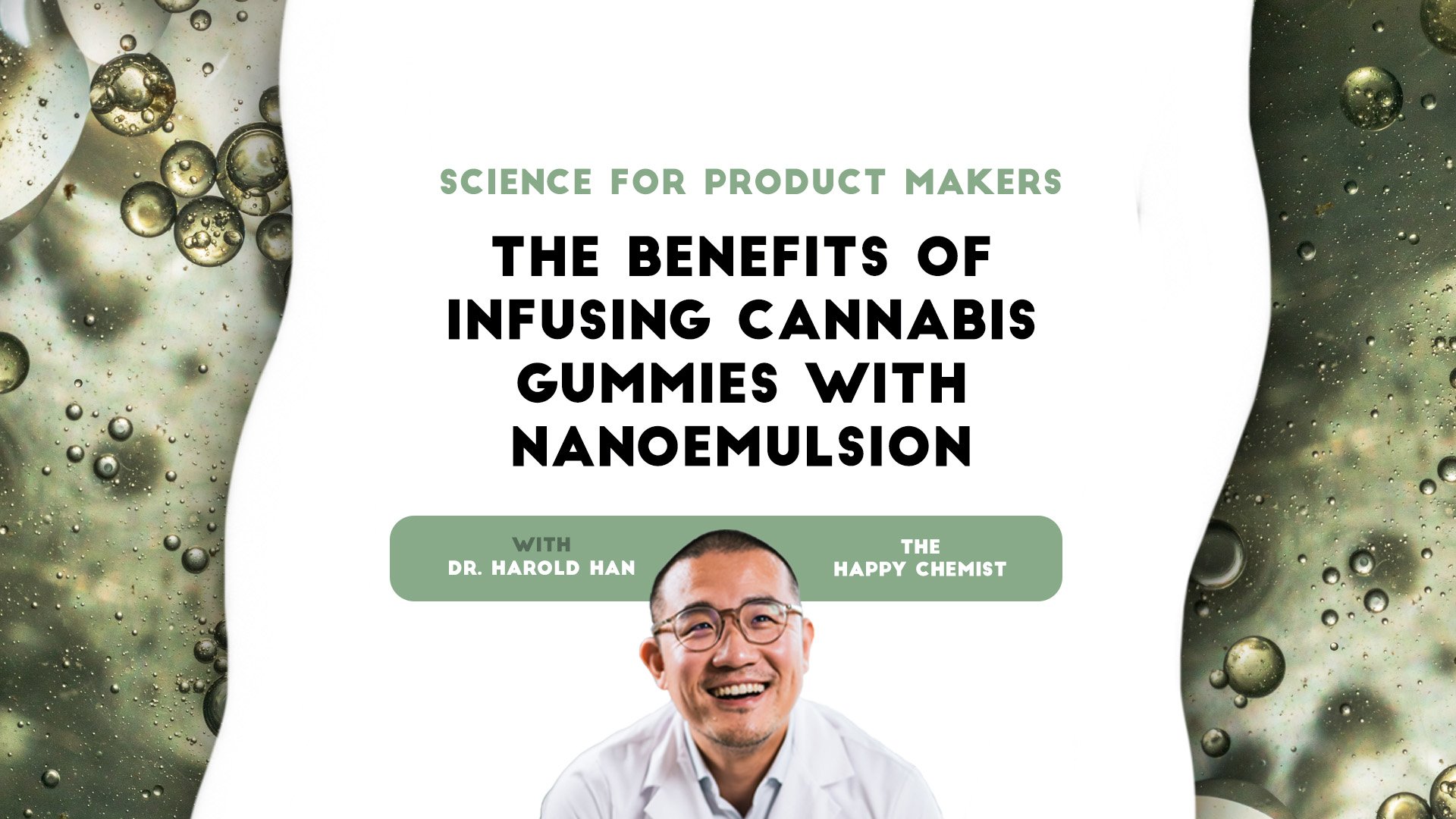Science for product makers: Why cannabis nanoemulsion offers quick onset
This post is also published as an article on Harold's LinkedIn profile. You can read and leave comments here. Our industry generally agrees that...
3 min read
 Dr. Harold Han - "The Happy Chemist"
:
6/28/24 5:04 PM
Dr. Harold Han - "The Happy Chemist"
:
6/28/24 5:04 PM

This post is also published as an article on Harold's LinkedIn profile. You can read and leave comments here.
My last post discussed different methods of administration through which cannabinoids can be absorbed into the bloodstream, including inhalation through the lungs, transdermal penetration through skin, mucosal absorption through the sublingual area and oral ingestion through the GI tract.
Each method provides a unique pathway for cannabinoids to be Absorbed, Distributed, Metabolized and Executed (ADME). Understanding the ADME pathway is the foundation for designing formulations and delivering target experiences in a cannabis infused product. In this post, I will illustrate THC’s ADME pathway after consuming a cannabis infused beverage.

The cannabis beverage enters the oral cavity first and then quickly moves through the esophagus into the stomach. If oral contact time is longer — for instance, if you were to sip a glass of cannabis infused wine — there may be a chance for a limited amount of THC to be absorbed through the mucosal system. This would bring THC into the bloodstream, bypassing the liver, which is often associated with a faster onset.
When formulated and produced correctly, the droplet size of the THC emulsion should not change in the acidic environment in the stomach. The direct absorption of THC in the stomach is low.
The THC emulsion droplets then travel to the small intestine, where a portion of them are transformed into Mixed Micelles, which is the main vehicle that facilitates THC absorption into the small intestine. THC that does not get transformed into Mixed Micelles may not be absorbed. They will most likely flow into the large intestine and later be excreted through feces.
Fat content from food is the main factor that can affect the THC absorption rate in the small intestine. You can read more about it in my previous post discussing how fat and food consumption affect THC uptake.
After THC is absorbed into the small intestine’s epithelial cells, it has two potential pathways:
My previous post discussed the hype and truth of “by-passing the liver”. In this stage, fatty acid content determines if the absorbed THC enters the liver or lymph. I would love to see more research focus on this area to truly understand the split between the two pathways.
THC that enters the liver is metabolized into 11-OH-THC by the enzyme CYP2C0, and then further metabolized into THC-COOH. THC-COOH is further metabolized into THC-COO-glucuronide, which is water soluble and thus can be excreted through urine.
11-OH-THC and THC-COOH metabolites go back into the bloodstream, which is why they can both be detected from a human pharmacokinetic (PK) study.
Now we have THC, 11-OH-THC, and THC-COOH present in the blood and flowing through every organ in our body. When they approach the brain, the Blood Brain Barrier (BBB) selects which compounds can enter the brain and blocks all others.
When THC enters into the brain and binds with CB1 and CB2 receptors, we start to feel the onset of the psychoactive effects. As for how the BBB works with cannabinoids, please check my previous post for more details.
When blood containing THC and its metabolites flows to organs rich with CB2 receptors, such as the spleen and spine, cannabinoids bind with CB2 receptors and create a therapeutic effect.
When blood containing THC and its metabolites flows past organs with high fat content (called depot), THC would likely bind with the fat and be stored inside of it to be slowly released over time back into the bloodstream. This is why a drug test can pick up signals long after consumption.
During this whole process, our liver never stops working. As blood containing THC and its metabolites keep flowing into the liver from other parts of the body, the liver keeps metabolizing THC into THC-COO-glucuronide to excrete it.
The description above summarizes the ADME (Absorption, Distribution, metabolism and excretion) process for THC. You can see that THC molecules end up in different places: some get absorbed and the rest get excreted. The absorbed THC molecules are continuously metabolized by the liver until all of them are excreted. During this process, THC and its metabolites bind with CB1 and CB2 receptors leading to the recreational and medical benefits.
Understanding THC’s journey through the body is a crucial component of creating cannabis infused products. I hope this information will help product makers design unique cannabis experiences for the consumer. I’m excited for the possibilities!
Dr. Harold Han — the “Happy Chemist” — combines his storied background in emulsion chemistry and science with curiosity and fascination in the rapidly growing cannabis industry. Developing nano and micro emulsions his entire career, Harold holds a Ph.D in Surface Chemistry from NYU and is the inventor of multiple patents in emulsion chemistry.
As the Chief Science Officer at Vertosa, Harold spearheads the company’s development of industry-leading and customized active ingredients for infused product makers, offering pre-suspended aqueous solutions to create incredibly homogenous and stable products while maximizing bioavailability, clarity, and taste.
To learn more about the science of cannabis, check out Harold’s Happy Chemist videos.

This post is also published as an article on Harold's LinkedIn profile. You can read and leave comments here. Our industry generally agrees that...

This post is also published as an article on Harold's LinkedIn profile. You can read and leave comments here.

This post is also published as an article on Harold's LinkedIn profile. You can read and leave comments here.